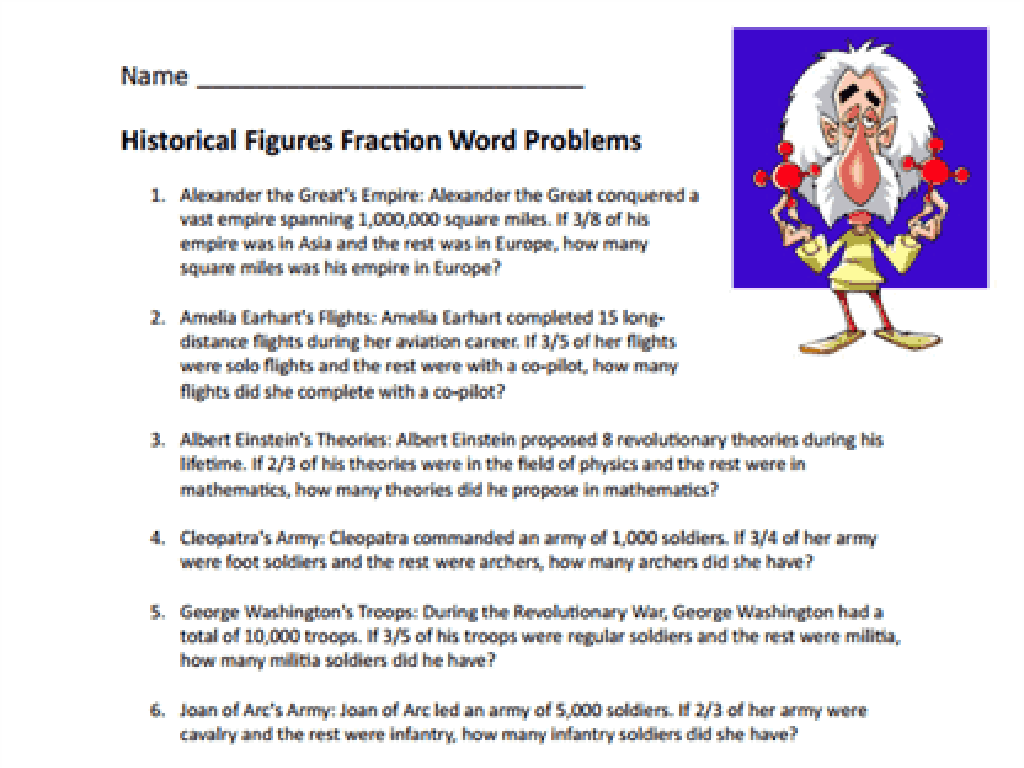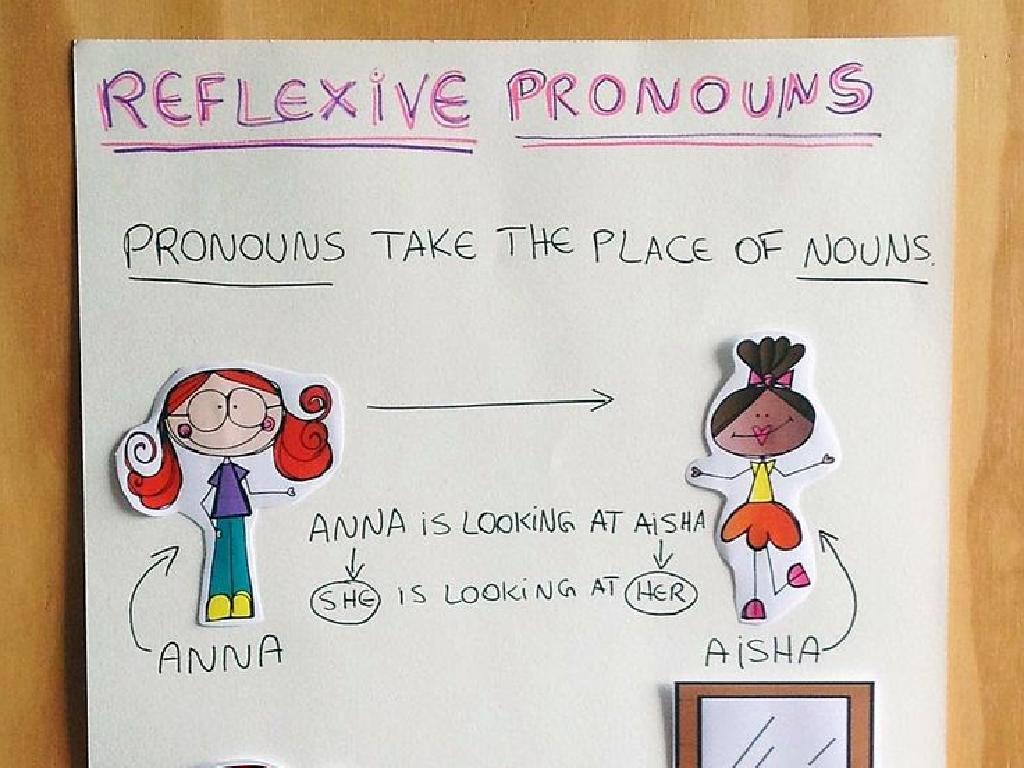Write Equivalent Expressions Using Properties
Subject: Math
Grade: Seventh grade
Topic: Equivalent Expressions
Please LOG IN to download the presentation. Access is available to registered users only.
View More Content
Welcome to Equivalent Expressions!
– Exploring equivalent expressions
– Equivalent expressions have the same value, even if they look different.
– Defining ‘Equivalent’
– ‘Equivalent’ means equal in value or meaning.
– Expressions and equality
– Using variables and constants to show equal values.
– Properties of equality
– Commutative, Associative, and Distributive properties help us rewrite expressions.
|
This slide introduces students to the concept of equivalent expressions in mathematics. Begin by explaining that equivalent expressions are different expressions that represent the same value. Clarify the meaning of ‘equivalent’ as being equal in value, function, or meaning. Discuss how expressions can be manipulated to show equality by using variables and constants. Highlight the importance of understanding the properties of equality, such as the Commutative, Associative, and Distributive properties, which allow us to rewrite expressions in different forms while maintaining their equivalence. Provide examples to illustrate each property in action and encourage students to think of their own examples.
Understanding Equivalent Expressions
– Define equivalent expressions
– Expressions with the same value, despite different appearance
– Simple examples of equivalence
– For instance, 2(3 + 4) and 6 + 8 are equivalent
– Significance in mathematics
– They simplify complex problems and show relationships
– Practice with expressions
|
This slide introduces the concept of equivalent expressions, which are different expressions that have the same value. It’s crucial for students to understand that while these expressions may look different, they represent the same quantity. Use simple examples to illustrate this point, such as showing how distributing or factoring can lead to equivalent expressions. Emphasize the importance of equivalent expressions in solving equations, simplifying expressions, and understanding algebraic relationships. Encourage students to practice creating their own equivalent expressions to reinforce the concept.
Properties of Operations: Crafting Equivalent Expressions
– Review key properties
– Commutative: a + b = b + a, Associative: (a + b) + c = a + (b + c), Distributive: a(b + c) = ab + ac
– Relate properties to expressions
– Use properties to rewrite expressions in different forms without changing their value
– Examples: Commutative Property
– Swap numbers in addition/multiplication: 3 + 5 = 5 + 3 or 2 * 4 = 4 * 2
– Examples: Associative & Distributive
– Group numbers differently: (2 + 3) + 4 = 2 + (3 + 4) or distribute: 2(3 + 4) = 2*3 + 2*4
|
Begin with a quick review of the commutative, associative, and distributive properties, ensuring students recall the basics. Explain how these properties allow us to write equivalent expressions, which look different but have the same value. Provide clear examples for each property, such as rearranging numbers in an addition equation for the commutative property, regrouping for the associative property, and breaking down expressions using the distributive property. Encourage students to practice with additional examples and to recognize these properties in action, reinforcing their understanding of how to manipulate and understand expressions in algebra.
Commutative Property of Addition and Multiplication
– Define Commutative Property
– Commutative Property allows us to rearrange numbers in addition or multiplication without changing the result.
– Examples: a + b = b + a, ab = ba
– For addition: 3 + 5 = 5 + 3. For multiplication: 2 * 4 = 4 * 2.
– Practice rearranging terms
– Try switching places of numbers in expressions: for 7 + 9 and 5 * 3.
– Understand property application
|
The Commutative Property is a fundamental concept in algebra that allows students to understand that numbers can be added or multiplied in any order without affecting the outcome. This slide introduces the property with a clear definition and provides straightforward examples for both addition and multiplication. Encourage students to practice by rearranging terms in given expressions to see the property in action. This will help solidify their understanding and prepare them for applying the property to solve algebraic equations. Make sure to provide immediate feedback during practice to correct any misconceptions.
Associative Property in Equivalent Expressions
– Explaining Associative Property
– It allows us to group numbers differently without changing the sum or product.
– Example: (a + b) + c = a + (b + c)
– For addition: (2 + 3) + 4 = 2 + (3 + 4). Both equal 9.
– Group terms to show equivalence
– Change grouping: (x + y) + z and x + (y + z) are the same.
– Practice with different numbers
|
The Associative Property lets us regroup terms in an expression without changing the result. It applies to both addition and multiplication but not to subtraction or division. Use numerical examples to show that regardless of how the numbers are grouped, the sum or product remains the same. Encourage students to practice with different numbers to become comfortable with this property. This understanding is foundational for algebraic manipulation and solving equations.
Using the Distributive Property
– Explaining Distributive Property
– Distributive Property lets you multiply a sum by multiplying each addend separately and then add the products.
– Example: a(b + c) = ab + ac
– If a = 2, b = 3, and c = 4, then 2(3 + 4) = 2*3 + 2*4.
– Expanding expressions
– Expand: 3(x + 4) becomes 3*x + 3*4.
– Factoring using distributive
– Factor: 15x + 20 into 5(3x + 4).
|
The Distributive Property is a key concept in algebra that allows students to multiply a sum by multiplying each addend separately and then add the products. This slide will introduce the property, provide a clear example, and guide students through the process of expanding and factoring expressions using this property. It’s important to emphasize that the distributive property is useful in simplifying algebraic expressions and solving equations. Encourage students to practice with additional examples and to recognize the property’s use in various mathematical and real-life situations.
Writing Equivalent Expressions
– Steps for equivalent expressions
– Use distributive, commutative, associative properties
– Combine like terms to simplify
– Like terms have same variables and exponents
– Practice with given scenarios
– Apply properties to write expressions for scenarios
– Understanding through application
|
This slide introduces the process of writing equivalent expressions, a key concept in algebra. Start by explaining the properties of operations distributive, commutative, and associative and how they can be used to rewrite expressions. Emphasize the importance of combining like terms, which are terms with the same variables raised to the same power, to simplify expressions. Provide practice scenarios for students to apply these concepts, such as rewriting 3(x + 4) + 2x using the distributive property and then combining like terms. Encourage students to work through problems step-by-step and to check their work by substituting values to see if the original and the new expression yield the same result. This hands-on practice will help solidify their understanding of equivalent expressions.
Class Activity: Expression Creation!
– Craft your own equivalent expressions
– Utilize properties to demonstrate equivalence
– Use commutative, associative, distributive properties
– Present and justify your expressions
– Explain the steps and properties used
– Engage with peers’ expressions
– Listen and discuss the reasoning behind classmates’ work
|
This activity is designed to reinforce students’ understanding of the properties of equality and how they can be used to create equivalent expressions. Students will apply the commutative, associative, and distributive properties to construct their own sets of equivalent expressions. They will then share their expressions with the class, explaining the reasoning and properties applied. This peer-sharing session will not only allow students to articulate their understanding but also expose them to different approaches and strategies used by their classmates. As a teacher, facilitate the discussion, correct any misconceptions, and ensure a respectful and constructive dialogue. Possible activities include pairing students to compare expressions, creating a gallery walk of expressions around the classroom, or having a ‘math debate’ where students defend their reasoning against others.
Wrapping Up: Equivalent Expressions
– Recap of equivalent expressions
– Review today’s lesson on creating expressions that are equal.
– Significance of properties
– Understanding properties helps simplify and solve expressions.
– Homework: Real-life examples
– Find instances where equivalent expressions are used in daily life.
– Share findings next class
– Be prepared to discuss how you found and applied the expressions.
|
As we conclude today’s lesson, it’s important to reinforce the concept of equivalent expressions and the role properties play in creating and understanding them. For homework, students are tasked with identifying real-life situations where equivalent expressions are applicable, such as in calculating discounts, recipes, or construction measurements. This exercise will help them see the practical application of what they’ve learned. In the next class, we’ll discuss these examples to deepen our understanding and see how math is used in everyday life. Encourage students to be creative and share unique examples.






